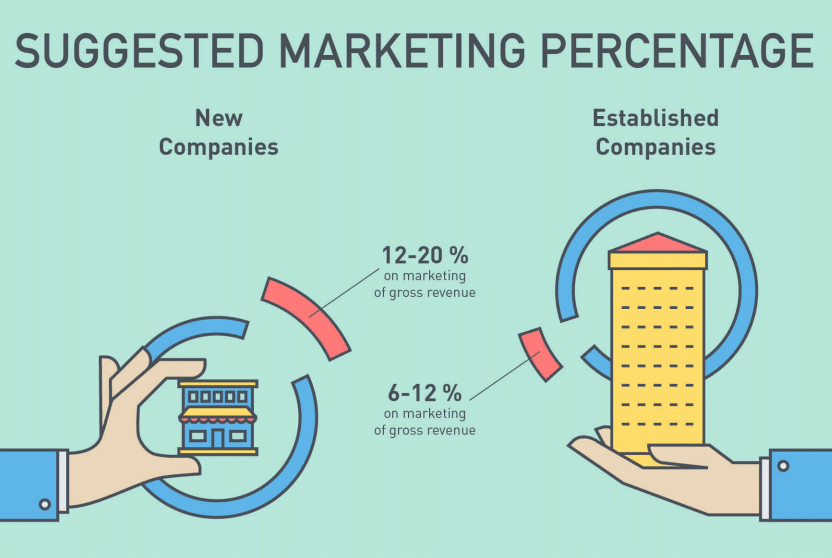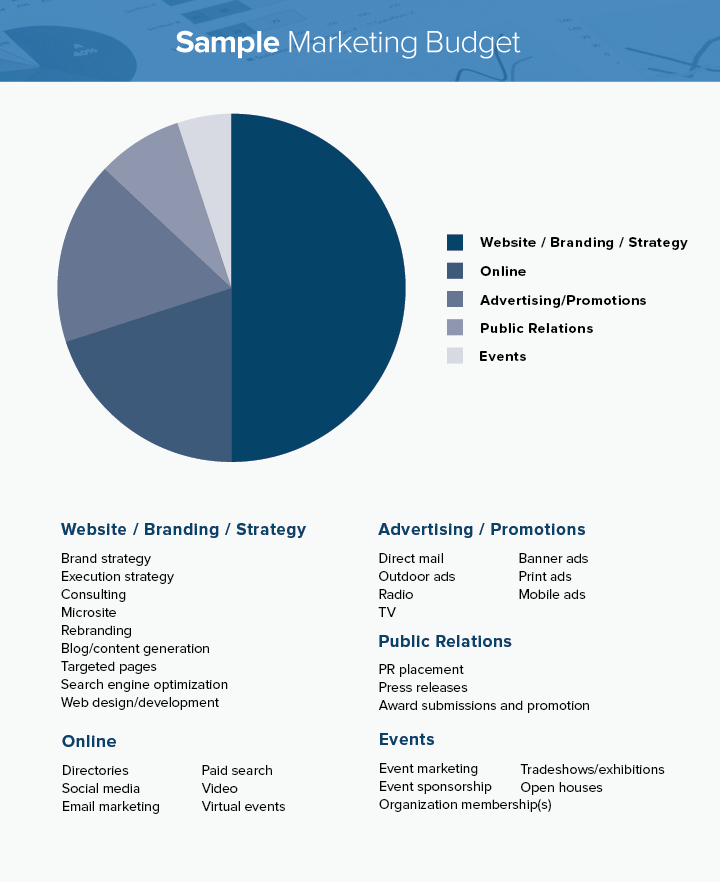I am asked this question……..(almost) every time I meet with a new prospect: How much do I have to spend to make money. TRICK QUESTION, but my answer to that question is always: “How Much Money Do You Want To Make?”
It’s NOT meant to be a smart-ass answer but if you have a Million dollar problem, but only want to ‘throw’ $100 at it, you’re not going to like the results. It’s like putting a band-aid over a bullet wound……..it might stop the bleeding for a second, but the end-result is not going to be good.
The 5% Rule
To understand the recommendation, first, let’s define ‘marketing budget.’ Your marketing budget refers to all costs for marketing, advertising, public relations, promotions and anything else you might blanket under that very wide-cast net called ‘marketing’ on a day-to-day basis: for example, Google AdWords, social media, print ads, sponsorships, collateral and even festivals.
As you’ll see below, the ideal budget depends on your current marketing foundations. BUT, as a general rule based on the latest research, expert opinions and years of marketing experience, we say:
You should spend 2–5% of your sales revenue on marketing.
The U.S. Small Business Administration recommends spending 7 to 8 percent of your gross revenue for marketing and advertising if you’re doing less than $5 million a year in sales and your net profit margin—after all expenses—is in the 10 percent to 12 percent range.

Compared with those findings and the findings of many similar studies, 5% doesn’t seem that large of a number. In fact, it seems pretty reasonable.
But we should clarify that our 5% rule applies to most years, not all, and covers most of your marketing, but not all.
There will be times when you have to spend more to get what you want and need, but those are special projects. Let us explain!
Building Your Foundation
Years that require more spending will arise whenever you need to invest in the foundation for all of your day-to-day marketing activities.
For example, an up-to-date, performance-based website is key—perhaps the key—to a solid marketing foundation. Why? Your website is available for both showcasing and selling your marketing services 24/7.
You will likely have to exceed your 5% marketing budget to update your website once every three to five years. Thus, the marketing foundation costs are not typically included in your 5%.
In general, your marketing foundation includes:
- Brand
- Marketing strategy
- Website design and development
- Other things of this nature
Without a solid marketing foundation, your day-to-day marketing activities will range anywhere from “not very effective” to “a waste of money.”
How to Spend Your Marketing Budget
If you are marketing from a fairly static annual budget, you’re viewing marketing as an expense. Good marketers realize that it is an investment. – Seth Godin
Now that you understand the 5% rule and the importance of your marketing foundation, it’s time to talk about where to spend your budget.
1) Set Marketing Goals
The first step toward marketing budget allocation is determining your marketing goals for the year. We recommend at least three S.M.A.R.T. goals with predefined success measures tied to each.
Here are some common ones:
- Increase website traffic—measured by unique visitors per month
- Increase targeted leads to the website—measured by web visits from our geographic service area
- Grow new business or develop new division—measured by total leads and sales revenue
2) Check Your Marketing Foundation
Next, examine your marketing foundation. Do you have the foundation in place to reach your goals?
Check your brand, website, communication pieces and reporting systems. Questions to answer:
- Do you have a clear, up-to-date brand that properly identifies your company and consistently generates the same brand image for consumers?
- Does your brand have a consistent look and feel across all media?
- How does your website compare to the competition? Tip: Google “mattresses [your primary region/city]” e.g., “mattresses Indianapolis,” and compare.
- Are there any barriers in your prospects’ path toward becoming customers?
- Do you have the tools and systems in place to measure the success of your marketing investment?
- Do you have a solid and solidified strategy for business development and marketing related to it?
3) Spend
With goals set and success measures in place, it’s time to allocate your marketing budget.
Your first priority is to remedy any weaknesses found in step two. Addressing weaknesses found in step two, more often than not, will be done with extra funding—marketing and/or business development funding—so you still have the full 5% of sales revenue to devote to day-to-day marketing activities.
Remember, both are necessary to launch your growth (with no traffic, even the best website in the world is worth very little).
With goals set and a strong marketing foundation (including a marketing strategy), you’re ready to select marketing activities.
The figure below should be enough to get you started! It’s a sample marketing budget for a catering company. And while this example is catering-specific, the categories and activities themselves are adaptable to many industries.

Now it’s your turn. How much do you spend on marketing?

 317-289-4965
317-289-4965